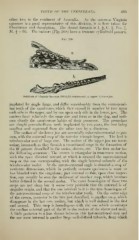Page 485 - My FlipBook
P. 485
TEETH OF THE VERTEBRATA. 495
other tM'o to the continent of Australia. As the common A^irsinia
opossum IS a good representative of this division, it is liere taken for
ilhistration and description. The dental formula is I. |, C. ]-, Pm. |,
M. ^ = 50. The incisors (Fig. 268) have a truncate cylindroid pattern,
Fig. 2G8.
Dentition of Virginia Opossum {Didelphis virginianuK) : a, upper; b, lower jaw.
implated by single fangs, and diifer considerably from the correspond-
ing teeth of the carnivores, which they exceed in number by two upon
each side in the upper, and by one upon each side in the lower, jaw. The
canines have relatively the same size and form as in the dog, and indi-
cate clearly the carnivorous habits of their possessor. The premolars
are simple premolariform teeth implanted by two roots, the first being
smallest and separated from the other tAvo by a diastema.
The molars of the lower jaw are essentially tuberculo-sectorial in pat-
tern, with the external cusp of the anterior triangle largest. The heel is
tritubercular and of large size. The molars of the upper jaw are inter-
esting, inasmuch as they furnish a transitional stage in the formation of
the W pattern described in the moles, shrews, etc. The first molar has
the folloM'ing structure : The crown is triangular in transverse section,
with the apex directed inward, at which is situated the antero-internal
cusp or the one corresponding with the single internal tubercle of the
tritubercular molar. At the antero-external angle is situated a cusp of
moderate dimensions, which in perfectly unworn specimens is more or
less blended with the cingulum just internal to this, upon close inspec-
;
tion, can usually be seen the rudiment of another cusp, which becomes
better defined in the second molar. The exact homologies of these two
cusps are not clear, but it seems very probable that the external is of
cingular origin, and that the one internal to it is the true homologue of
the antero-external cusp of the tritubercular tooth. On the outer edge
of the crown, ])osterior to the two just described, is another cusp, which
disappears in the last two molars, but which is well defined in the first
and second. This cusp is homologous with the one which terminates
the median external part of the W in the molars of the shrew and mole.
A little posterior to a line drawn between this last-mentioned cusp and
the one most internal is another large well-defined tubercle, from which


